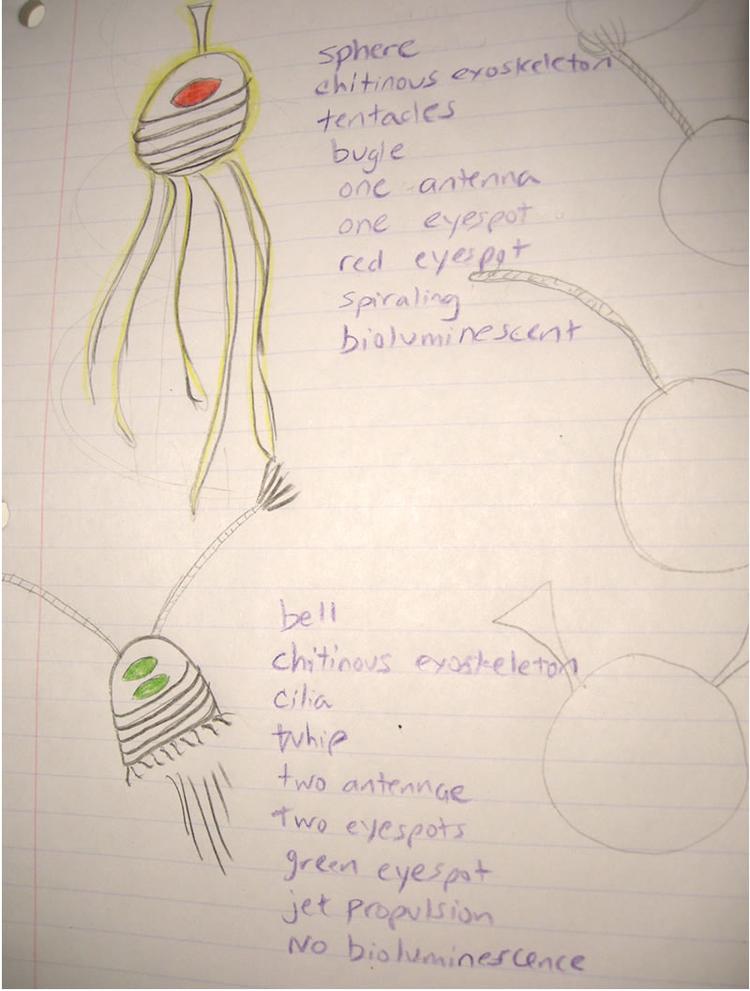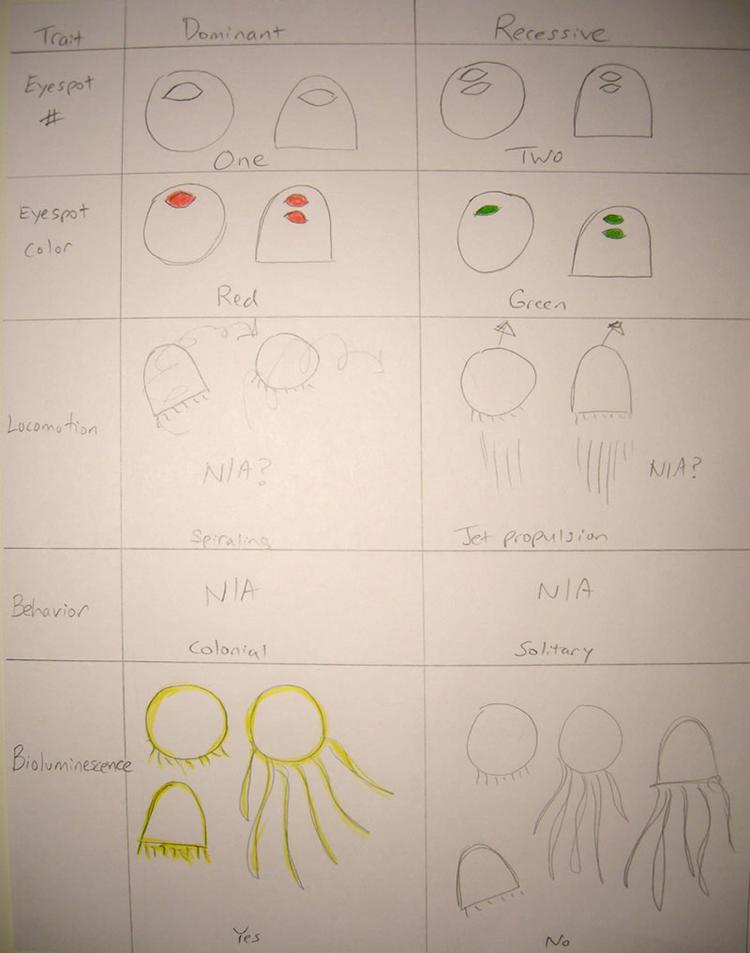| Complexity level: | 7 |
| Time required: | The student needs to perform coin tosses and draw a creature using a key. |
| Material availability: | You will need some pennies, paper and colored pencils - all of these are easily found at home. |
| Safety concerns: |
Overview
Have you ever looked around and marvelled at how different one person is from another in terms of physical appearances as well as behaviour? Some people are tall and others are short. Some people are talkative, while others are quiet.
Perhaps you and your sibling are nothing alike! Or perhaps you look a lot like one of your relatives? In that case you may wonder, what are the odds of you looking so much like your relative?
In fact, it isn't so strange to think about the odds of a person turning out the way they are. We are all a result of the combined influence of our genes and our environment - nature and nurture. Certain traits, however, are largely determined by our genes. The best example of this is whether we are male or female. We each have 23 pairs of chromosomes. Remember, a chromosome contains our DNA and our DNA determines our traits. If we are female our 23rd chromosome pair is XX, but if we are male our 23rd pair is XY.
When an ovum (human egg) is fertilized, half of its genetic material comes from the mother and half from the father. Every baby inherits an X from Mom, and either an X or a Y from Dad. The likelihood of having a particular outcome for an event is called probability. In this case, the event is the baby, or egg fertilization, and the outcome is its sex. Consider a coin toss. If there are two possible outcomes with every coin toss, what is the probability of flipping heads? Since the coin is not weighted on one side, flipping heads or tails are both equally likely outcomes. When the probabilities of two outcomes are equal, each is expressed as 1/2 (50%).
Your phenotype consists of all your traits that are visible to others, such as appearance and personality, as well as many traits that aren't. You have traits that you may have never guessed are part of your phenotype, including blood type, hormone levels and metabolic rate. In fact, your phenotype is simply the expression of your genes, or your genotype.
A variation of the same trait, such as type A or type B blood, is called an allele. For all genes that humans have, we get one allele from our mother and one allele from our father. In the case of sex determination, a male gets one X allele from Mom and one Y allele from Dad. For every one of our thousands of genes, there is more than one allele. In fact, sperm and egg cells are genetically unique from other sperm and egg cells from the same person. Because of this there are thousands or hundreds of thousands of possible "yous".
Alleles can be dominant or recessive, although genetics is often more complicated than that because a trait can be controlled by more than one gene. If an allele is dominant, the person will have the dominant trait. If an allele is recessive, the person needs two recessive alleles, one from each parent, to have the recessive trait. In genetics, dominant alleles are represented by capital letters, while recessive alleles are represented by lower-case letters.
We can use punnett squares to determine the probability of getting a certain phenotype when crossing the two genotypes of the parents. In the case of sex determination, the genotype of each phenotype, male and female, is known. An example of a punnett square used to determine the probabilities of getting male or female offspring is provided below. The possible genotypes of the offspring are in red in the center of the table. The alleles each parent can donate to the offspring are in bold on the outside of the table. Because there are 2 XX (females) and 2 XY (males) produced, either genotype is equally likely.
|
Alleles from the father |
|||
|
X |
Y |
||
|
Alleles from the mother |
|
|
|
|
|
|
|
|
Scientific Terms
Materials
Pennies
Paper
Colored pencils
Procedure
For this science fair project, let's put on our jet packs and head to the planet "Planktonia" to perform some breeding experiments. Students, heed this warning: keep your breathing mask on at all times, and please, do not swim in the water!!
- Use the key provided ("Zoomonsters of planet Planktonia") to design your "zoomonster". To do this you are going to perform 10 coin tosses, one for each of the traits described by the key. If you get heads, you will choose the dominant trait under the heads column. If you get tails, you will choose the recessive trait under the tails column. As you perform the coin tosses, make a list of the traits that you get with each toss.
- You will use the list of traits that you made in step 1 to draw your zoomonster. Because there are ten traits each with two alleles, there are many possible outcomes for your zoomonster. Examples of what your zoomonster might look like are provided.
- Once you have designed your zoomonster, pair up with a friend who has designed his or her own zoomonster. If you are doing this activity alone, design two zoomonsters separately by following steps 1 and 2 twice.
- Now you are going to calculate the probability of getting certain phenotypes with your zoomonster pairing. The first step is to use the key to determine the genotypes of the two zoomonsters. The genotype is the sequence of letters used to represent the phenotypes of your zoomonsters. Refer to the table provided for the phenotypes and their corresponding genotypes. You may notice that the dominant traits have two possible genotypes, homozygous dominant (AA) or heterozygous (Aa). To simplify, you are going to choose the homozygous dominant genotype.
- Once you have determined your zoomonster's genotype, pick 4 traits that you will make predictions about using a punnett square for each trait separately. For example, you can choose body shape, antenna type, bioluminescence and appendage type. You will make four punnett squares, one for each of your four chosen traits. Refer to the example provided for assistance with setting up a punnett square.
As an example, let's say you have chosen to make predictions about possible antenna types in the offspring given your zoomonster pairing. Your zoomonster has whip antenna (genotype dd), while your partner's zoomonster has bugle antenna (genotype DD). To predict the genotype of the offspring, set your punnett square up like this:
|
Alleles from the father (bugle antenna) |
|||
|
D |
D |
||
|
Alleles from the mother |
|
|
|
|
|
|
|
Welcome to the planet Planktonia!
It's time to create your Zoomonster planktonites!
All students heed this warning:
Do not swim in the water and please keep your breathing mask on at all times!!
|
Trait |
Heads |
Tails |
|
Body shape |
Sphere |
Bell |
|
Body type |
Chitinous exoskeleton |
Gelatinous |
|
Appendage type |
Cilia |
Tentacles |
|
Antennae type |
Bugle |
Whip |
|
Antennae # |
One |
Two |
|
Eyespot # |
One |
Two |
|
Eyespot color |
Red |
Green |
|
Locomotion |
Spiraling |
Jet propulsion |
|
Behavior |
Colonial |
Solitary |
|
Bioluminescence |
Yes |
No |
Table 1. Coin toss traits.
|
Dominant |
Recessive |
||||
|
Trait |
Allele |
Genotype |
Phenotype |
Genotype |
Phenotype |
|
Body shape |
A,a |
AA, Aa |
Sphere |
aa |
Bell |
|
Body type |
B,b |
BB, Bb |
Chitinous exoskeleton |
bb |
Gelatinous |
|
Appendage type |
C,c |
CC, Cc |
Cilia |
cc |
Tentacles |
|
Antennae type |
D,d |
DD, Dd |
Bugle |
dd |
Whip |
|
Antennae # |
E,e |
EE, Ee |
One |
ee |
Two |
|
Eyespot # |
F,f |
FF, Ff |
One |
ff |
Two |
|
Eyespot color |
G,g |
GG, Gg |
Red |
gg |
Green |
|
Locomotion |
H,h |
HH, Hh |
Spiraling |
hh |
Jet propulsion |
|
Behavior |
I,i |
II, Ii |
Colonial |
ii |
Solitary |
|
Bioluminescence |
J,j |
JJ, Jj |
Yes |
jj |
No |
Table 2. Genotype key.
You will notice that the dominant traits have two possible genotypes: a homozygous dominant (AA) and a heterozygous (Aa). To simplify, you are going to use the homozygous dominant genotype. The genotype for a zoomonster with the traits bell, gelatinous, cilia, one bugle antenna, two red eyespots, spiraling, solitary and non-bioluminescent is: aa/bb/CC /DD/ff/GG/HH/ii/jj
Figure 1. Some examples of zoomonsters

Figure 2. Zoomonster traits, part 1

Figure 3. Zoomonster traits, part 2




